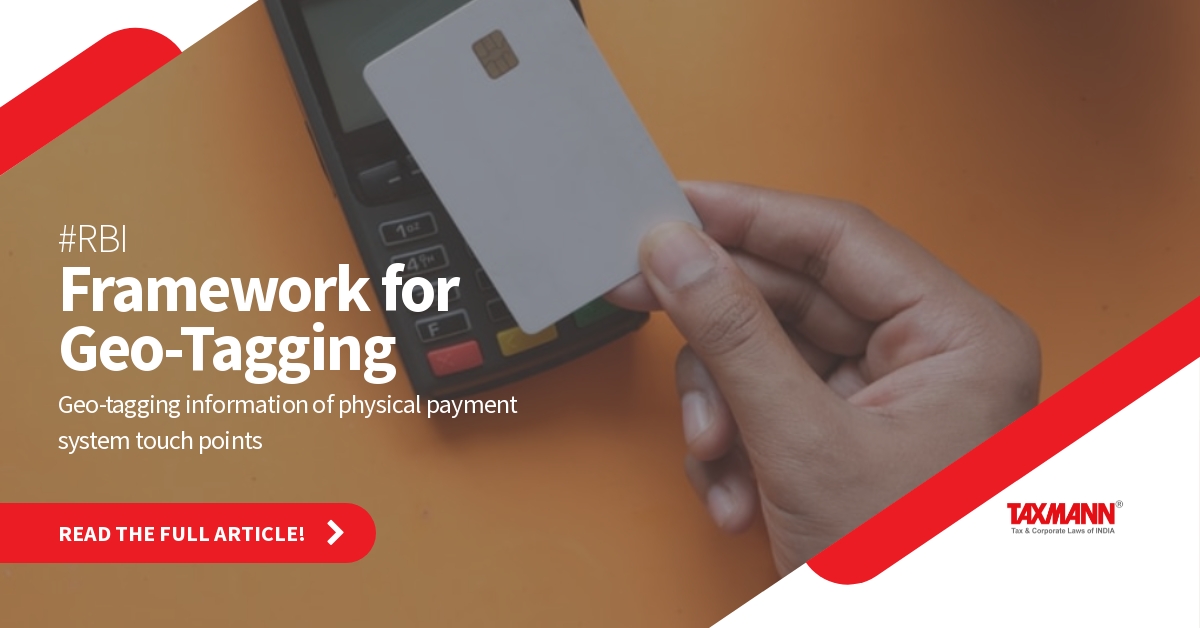RBI lays down framework for capturing geo-tagging information of physical payment system touch points
- Blog|News|FEMA & Banking|
- 2 Min Read
- By Taxmann
- |
- Last Updated on 28 March, 2022
Introduction
RBI vide. Circular No. RBI/2021-22/187 CO.DPSS.OVRST.No.S1738/06-08-018/2021-2022, Dated, 25-03-2022 has prescribed a framework for capturing geo-tagging information of physical payment system touch points deployed by banks/non-banks. The framework has been issued under Section 10 (2) read with Section 18 of Payment and Settlement Systems Act, 2007.
Background
The vision of RBI on laying out the framework is to deepen the digital payments and providing inclusive access to all citizens of the country, irrespective of their location or digital literacy.
RBI viewed that it is imperative that a robust payment acceptance infrastructure with multiple types of touch points exists across the length and breadth of the country and is available and accessible at all times
RBI emphasised on capturing the accurate location of existing payment system touch points / acceptance infrastructure is essential to upscaling and chalking out intervention strategies and this requirement can be effectively facilitated by geo-tagging of payment touch points. This write-up aims to discuss the key highlights of the framework in details.
1. Meaning of ‘Payment Touch Points’
Payment touch points refer to as capturing the accurate location of existing payment system touch points/acceptance infrastructure.
2. Meaning of ‘Geo tagging’?
Geo-tagging refers to capturing the geographical coordinates (latitude and longitude) of payment touch points deployed by merchants to receive payments from their customers. It offers various benefits such as providing insights on regional penetration of digital payments, monitoring infrastructure density across different locations; identify scope for deploying additional payment touch points; facilitate focused digital literacy programmes.
Click Here To Read The Complete Article
Disclaimer: The content/information published on the website is only for general information of the user and shall not be construed as legal advice. While the Taxmann has exercised reasonable efforts to ensure the veracity of information/content published, Taxmann shall be under no liability in any manner whatsoever for incorrect information, if any.

Taxmann Publications has a dedicated in-house Research & Editorial Team. This team consists of a team of Chartered Accountants, Company Secretaries, and Lawyers. This team works under the guidance and supervision of editor-in-chief Mr Rakesh Bhargava.
The Research and Editorial Team is responsible for developing reliable and accurate content for the readers. The team follows the six-sigma approach to achieve the benchmark of zero error in its publications and research platforms. The team ensures that the following publication guidelines are thoroughly followed while developing the content:
- The statutory material is obtained only from the authorized and reliable sources
- All the latest developments in the judicial and legislative fields are covered
- Prepare the analytical write-ups on current, controversial, and important issues to help the readers to understand the concept and its implications
- Every content published by Taxmann is complete, accurate and lucid
- All evidence-based statements are supported with proper reference to Section, Circular No., Notification No. or citations
- The golden rules of grammar, style and consistency are thoroughly followed
- Font and size that’s easy to read and remain consistent across all imprint and digital publications are applied








 CA | CS | CMA
CA | CS | CMA


